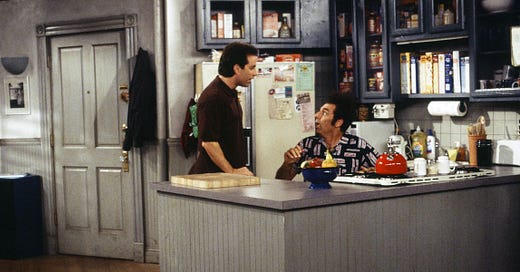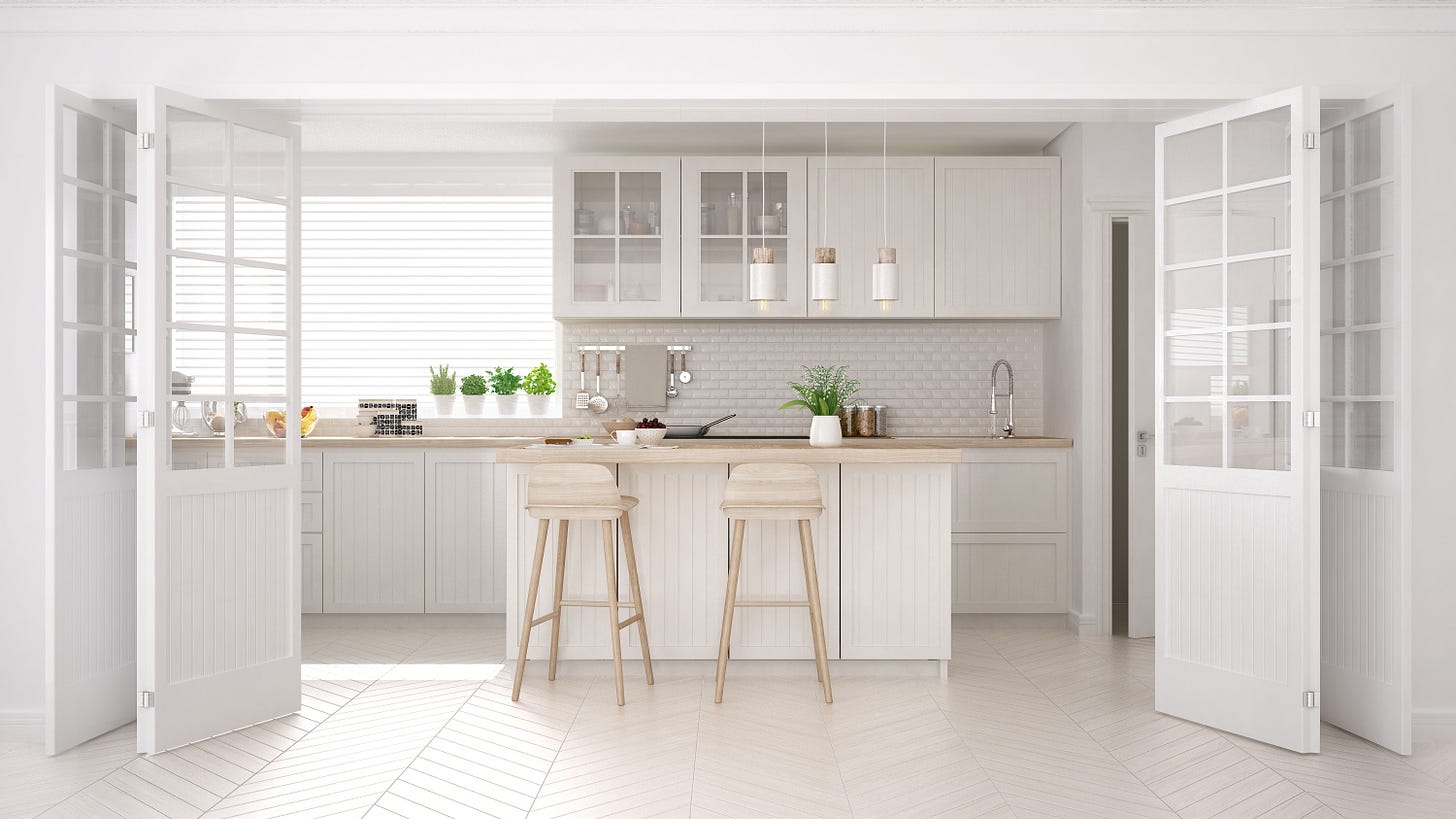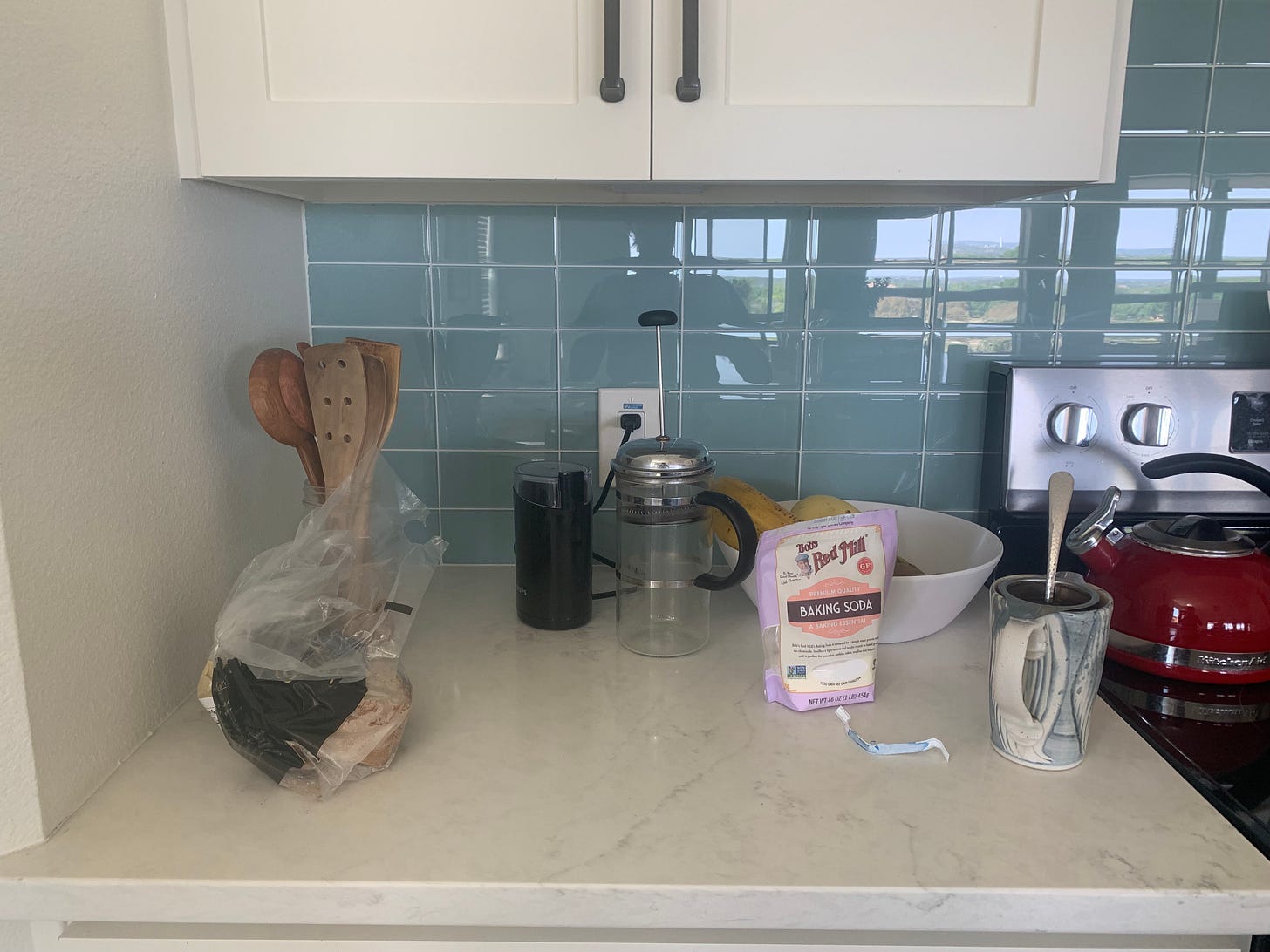Lately, I’ve been thinking about clutter and tidiness on both personal and cultural levels. These thoughts were prompted by two vastly different things: Seinfeld and Toggl. You’ve probably heard of the sitcom, so let’s dive into Toggl first.
Toggl is a time-tracking app, and I’m shocked to say that I’ve been consistently tracking my time for the last six months. I track everything — from work tasks to walking my dog to picking the weeds. It might sound a little uptight, but I’ve found a lot of freedom in it. Now that I finally understand how long tasks actually take, I’m able to accurately plan my days:
Because running to the grocery store and back does not take 15 minutes.
And doing that one dreaded task on my list? Once I start, it takes 30 minutes instead of the anticipated three-and-a-half hours.
Something I’ve also learned? I clean and tidy. A lot. A lot a lot.
When I check out my Toggl stats each week, my top focus is career-related, and then the “cleaning” and “cooking” categories are at a head-to-head race for second and third place. Of course, this is common for many adults — especially women. Personally, though, I was surprised by the amount of time dedicated to tidying. Sure, it felt like I was constantly cleaning and tidying, but I was surprised the stats actually confirmed this feeling. How do I tidy this much? Why? We’re just two adults and a dog living in a normal house.
Historically, I related more to Carrie’s level of tidiness than to Charlotte’s because I always liked a little disorder when I was in the middle of a creative project.

The disorder seemed to symbolize an abundance of ideas and possibilities versus an intimidating clean and blank slate. So this tidiness thing is new to me, and like many new habits, it started during the pandemic. During the first half of 2020, my husband, dog, and I lived in a 600-square-foot studio apartment. With the lack of space, as well as the golden dog hairs gleaming against the dark floors, I started to constantly clean and organize. After all, if I left clothes on our bathroom floor, I was also leaving them in our closet/laundry room/occasionally my office (if I needed a quiet place for a conference call).
In August 2020, we moved into our first home — a three-bedroom, 2000-square-foot space that was built just the year before and felt like a mansion. I didn’t know how we would possibly fill the space; after all, the only furniture we owned included a mattress, two desks and their respective chairs, a recliner, a rug, and a TV. Amidst our small furniture haul, I also carried along my new habit of tidiness, and this habit endured as we filled our space and accumulated more items. Today, I still find it hard to sit or write or relax until our space is organized.
This brings us to Seinfeld, which prompted me to think about tidiness on a cultural level. (Note that I’m talking about tidiness and not cleanliness). Take a look at Jerry’s kitchen:
Like any relatable kitchen in the 90s, there’s always a lot happening:
a spread of packaged snacks across the top of the fridge
papers, notices, and mismatched magnets plastering the fridge door
glass-door cupboards that are stocked with packaged goods
an accessible row of cereal boxes
an array of other items — from the kettle to dish soap to an electric can opener
Similar kitchens can be found in other shows too (e.g. Friends or The Sopranos). I certainly grew up in a house that looked more like this than what we see on screens today.

The homes from yesteryear were unkempt and lived in. The glass left on the table or the mail pile near the door or the dog leash on the floor said, “There are people and animals here. Life is being lived here.” And there’s something refreshing, real, and of course relatable about that.
I wanted to hear my friend’s insights on this. Sara Fritsch owns an organizing business called Moxie Space and thinks about this stuff — and literal stuff — all day long, so I knew she would have an illuminating take. First, she dubbed the 90s look as “Cluttered Aesthetic,” which really is the perfect term. She also shared her thoughts on today’s aesthetics, reflecting that “it’s like we’re trying to hide” by having a bounty of storage and tucking everything away. “At the same time, we have open-concept layouts, so it’s like we’re trying to reveal everything. We are losing our boundaries.”
To Sara’s point, there were more walls in the 90s. Therefore, if you invited company, they may have seen your neat entrance and living room, but your unsightly kitchen with all of the markers of “life” could remain hidden. Now, the designs are minimalist and open concept. If I invite you into my home, you’ll see my entrance, living room, dining room, and kitchen. The mess in one spot (e.g. the dining room, which isn’t really a “room” anymore) is no longer contained and instead spills into the entire space. Additionally, compared to my childhood kitchen, my current kitchen not only contains extra counter space, but also a large pantry and oodles of storage. In other words, I don’t have to leave my toaster, InstantPot, and utensils on the counter and instead can simply tuck them away. The utensils I do leave out are part of the curated decor, for goodness’ sake!
Today’s modern homes, which not only grace our television screens and digital magazines, but also social media apps, are beacons of tidiness. Many of the videos and photos (including mine from above!) invite anyone into our homes, but these glimpses only share what is curated. Instagram ads feature Tide in beautifully-curated laundry rooms or the latest Kombucha on the scrubbed marble counters of an exquisite, gleaming kitchen. Architectural Digest lets us peek into elaborate homes that have intentionality poured into them. Yes, every item in a 90s home had a story of some sort, but it feels like items were chosen on an individual basis versus how they fit into the whole aesthetic. The look was eclectic and pastiche and less . . . streamlined and sterile.
Like clothing or interior design trends, there are probably cycles when it comes to tidiness. Yes, the 1950s housewives were expected to keep their mid-century modern places “spick and span,” but the 1970s’ maximalism seemingly invited clutter. In 2011, Marie Kondo inspired a nation to ask whether our objects “sparked joy,” and the pandemic prompted many people to declutter the homes they now spent inordinate amounts of time inside. However, Gen Z is resurrecting the 90s clothing aesthetic, along with imperfect and blurry photos. This generation is not keeping up with appearances, and they also (thankfully!) seem to discard the inflated performance of authenticity. So perhaps they’ll shake things up when it comes to tidiness, and according to the rumor mill, this is already the case.
However, don’t get me wrong — I love being part of the minimalist-adjacent movement that engages in more sustainable and intentional purchasing. Plus, I think my head would explode if my granola lived with my other snacks on top of the fridge. Part of me loves order. I recently reorganized our bookshelf, and each time I glance at it, I feel pleased with the balanced and artistic display. But when my other priorities (like working out or working on something creative) are shoved to the side because the floor is littered in dog toys or a few pieces of laundry, that’s when it becomes a problem. Procrastinating on my true priorities or trying to perfect our space isn’t how I want to spend my time — even though Toggl says that’s exactly what I’m doing. The solution? Instead of organizing my stuff, it’ll be more useful for me to reorganize how I spend my time.
This Minor Epiphany recommends:
Catherine Newman’s refreshing home tour (Dishes are drying on the rack and the dish soap container isn’t tucked underneath the sink; board games are stacked in plain sight; the shower contains a slew of products vs just a bottle of Aesop).
Sara Peterson’s article on the above home tour









I loved this! Such a rich topic. Reading this was equal parts fun and enlightening. <3